WHAT IS BENACHIN?
Benachin is a traditional Gambian dish consisting of rice, vegetables, and meat, all cooked together in a single pot. It is also known as thiebou-dienne, a Senegambian special jollof rice. Benachin translates to “one pot” in Wollof, referring to its cooking method.
The dish is characterized by its aromatic flavours, thanks to ingredients like habanero peppers, onions, garlic, tomatoes, and bay leaves.
Benachin can also be made with various vegetables, including carrots, sweet potatoes, butternut squash, eggplant, cassava, and cabbage.
It is typically served with roff, a parsley-based stuffing. Benachin is a popular and healthy meal, perfect for lunch or dinner.
3 REASONS TO TRY THIS GAMBIAN JOLLOF RICE
- One Pot Wonder – Benachin literally means “one pot” – this recipe contains lots of healthy vegetables, flavorful spices, and complete with your choice of beef or mutton – all cooked in one pot. Easy to cook, easy to clean, and extra yummy to eat!
- Easy to be made vegan or vegetarian. Yes, Benachin can be made to be vegan or vegetarian. The traditional recipes usually call for fish and a whole chicken, but those ingredients can be easily replaced with vegetables such as onions, hot peppers, green pepper, tomatoes, and season vegetables like carrot, cassava, cabbage, eggplant, bitter tomato, okra, potato, or pumpkin. Additionally, vegetable oil and water can be used as substitutes for traditional animal fats.
- Easy to substitute meat of choice. Some of the ingredients that can be used to make Benachin include rice, tomatoes, tomato paste, chilli peppers, onions, salt, and spices. Depending on the region and preference, proteins such as chicken, beef, mutton, or fish can be added, either as a side dish or directly in the pot. For a vegetarian version, Ghana’s recipe includes fried plantains. For regional quirks, Liberia might not include fish while Senegal may prefer it, and Cote d’Ivoire and Mali may not include okra or nuts.
You May Also Like….
If you love rice recipes, you might also want to check out Peruvian-Cantonese fried rice or Korean Bulgogi. If you like one-pan dishes, you might want to check out a quick and easy Tunisian one pan dish of eggs and veggies in tomato sauce.
When you find a dish like benachin mentioned in the same train of thought as Nelson Mandela, it’s invariably a good sign.
Dubbed one of the 7 Wonders of Africa in a tongue-and-cheek reference to Mandela, Cape Town and Senegalese hair twists, it should thus be no surprise that the origin of benachin – a West African tomato-soaked rice dish known also as jollof rice elsewhere – remains hotly debated throughout West Africa.

BENACHIN: THE ONE-POT WONDER
In Gambia, benachin means “one pot,” a name referring to the way of cooking a single pot over a roaring fire in days of yore.
The word comes from the language of the Wolof (also known as Jollof) people – the third largest ethnic group in Gambia and the most populous in neighboring Senegal. The history of the Wolof people goes back many centuries, but it reached a two-hundred-year climax from the middle of the 14th century onwards when the Wolof Empire ruled over large swathes of coastal area now part of Senegal and just above Gambia.
In the mid-15th century, the Portuguese were sniffing around the West African coast, looking to establish a trading fort on Arguin island off the coast of Mauritiana and delve deeper into the continent from Senegal to Liberia. In 1446, Portuguese chronicler Gomes Eanes de Azurara writes of the Gambian River as a “country covered by vast crops, with many cotton trees and large fields planted in rice.” The Portuguese soon came to admire the natives for their special techniques in growing rice, and the basin south of the Senegal river came to be known as the Rice Coast.
Still, as we learned in Angola and Mozambique, the Portuguese had a penchant for importing favored ingredients with them, and Senegambia proved to be no different. Among the various imports the Portuguese and other Europeans brought with them to the region were ingredients like tomatoes, carrots, and cabbage.
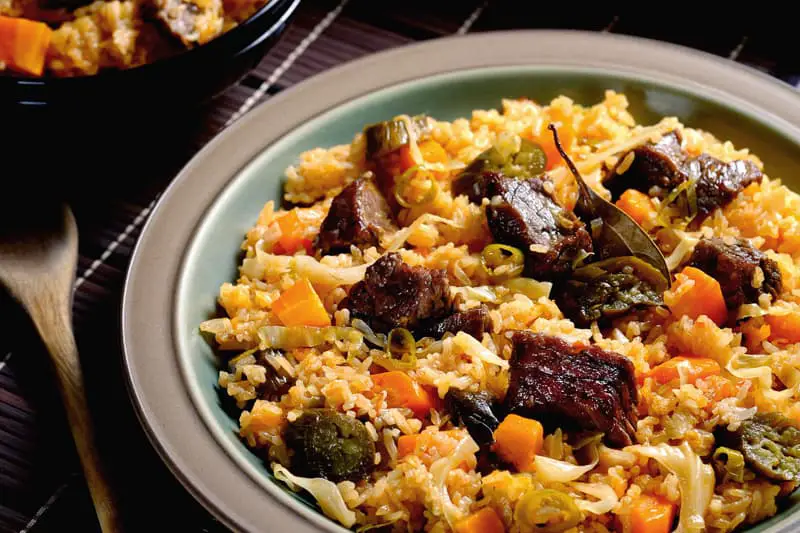
What is the difference between Benachin and other Jollof rice recipes?
The ingredients and techniques of preparation used in Benachin differ significantly from those used in other Jollof rice dishes. Rice, veggies, and meat are all cooked in the same pot and are usually included in benachin, which originates from the Gambia.
In addition to fish, okra, almonds, and other proteins, other Jollof rice recipes come from countries including Liberia, Senegal, Cote d’Ivoire, and Mali. The kinds of spices used in each dish might also differ. For instance, the Jollof rice from Senegal could have more chili peppers whereas the one from Liberia might not have any.
Additionally, other Jollof rice recipes could call for fried plantains as a side dish even though benachin is often served as the main course. The final difference between recipes is how the ingredients are introduced to the pot. For instance, some recipes specify that the proteins should be cooked as a side dish rather than being placed to the saucepan immediately.
WOLOF OR DJULA?
Considering the background of agriculture and imported food into the region – even the dish’s name – it seems like a no-brainer that benachin would be the lovechild of a culinary relationship between the Wolof people and European traders and colonizers. Many historians, however, are not so convinced.
Given the way culture and language spread (or didn’t spread so well) through the Wolof Empire, some historians claim that it was unlikely that Wolof food culture would have been so mobile. The more likely scenario, according to historian and author James C McCann, is that the dish had already diffused through the region in the days of the further-reaching Mali Empire dating back to the 13th century. In this situation, the Djula people – tradesmen who traveled between key towns and cities in the region – were supposedly the most likely carriers of the one-pot rice dish.
Throughout West Africa, the debate rages on everywhere but Senegal, where the origin of their benachin comes from a local legend. According to Senegalese lore, the dish was invented by a home-born national called Mam Penda Mbaye, who was herself a Wolof. She was a cook at the local governor’s residence, or for family festivals (depending on which source you want to go with) and it was she who had the idea of adding cherry tomatoes to the rice to jazz it up. The meal, called “thiéboudienne” for the fish version and “thiebouyapp” when made with meat, quickly made its rise to the status as the Senegalese national dish.
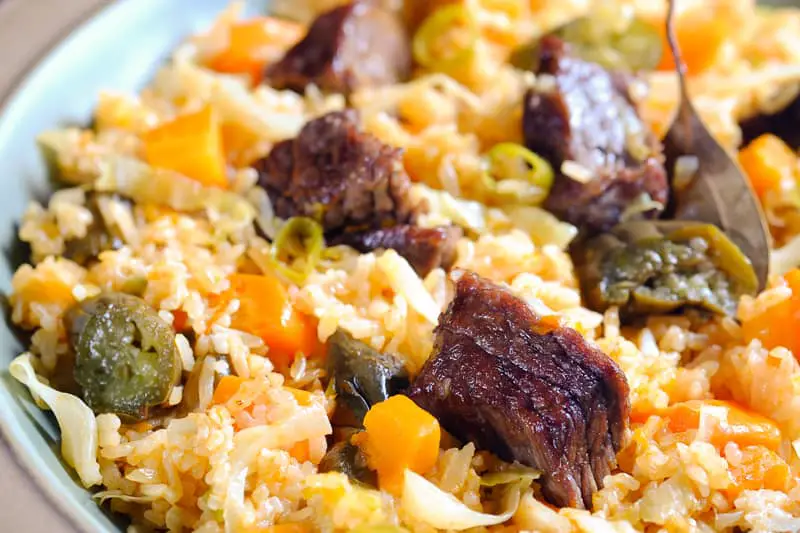
WHAT IS THE ORIGIN OF BENACHIN?
Benachin has turned out to be one catchy dish, stretching all the way to Nigeria via Sierra Leone, Liberia, Ghana and Togo. Competition is rife between the countries as to whose rice dish – called “riz au graz” in francophone countries and jollof rice to Ghanaians and Nigerians – is the best.
#jollofwars is one hashtag that has emerged from the perpetual – and mostly lighthearted – debate between countries as to who makes the best rice dish. Not content with containing itself in West Africa, the playful rivalry has spilled over to international diasporas, with jollof cook-off contests taking place in Toronto and New York.
And then there’s #jollofgate. For those of you not in the loop of rice recipe scandals, the name Jollofgate was given to an incident back in 2014 when Jamie Oliver came under fire for daring to appropriate the culinary deity that is Jollof Rice. His addition of cilantro, parsley, lemon and (gasp!) vine cherry tomatoes sparked outrage among west Africans who felt their national treasure had been all but trampled into the ground by the celebrity chef and his outlandish additions.
Jollofgate served as a great reminder to us all just how valued the dish really is. In fact, benachin/jollof rice is so revered that August 22nd is officially World Jollof Rice Day. Be sure to mark your calendars.
ABOUT THE RECIPE
Although there are plenty of differences in the way benachin is prepared around West Africa, each dish shares a common base of rice, tomatoes, tomato paste, chilli peppers, onions, salt, and spices. Also, what’s important to any recipe you try is having everything cooked together in one big pot.
It’s the other ingredients that give rise to all this variation. Different recipes call for different proteins (some chicken, some beef, some mutton, others fish) to be added, and how it’s added – whether as a side dish or directly in the pot – can’t be agreed upon either. For vegetarians looking to enjoy a meatless version, Ghana’s recipe includes fried plantains on the side.
This is just the tip of the iceberg for regional quirks, however. Liberia’s disapproves of a fishy Jollof while the Senegalese love it. Folks in the Cote d’Ivoire and Mali frown upon the addition of okra or nuts where it’s perfectly acceptable elsewhere.
HOW TO MAKE BENACHIN
Going through the procedure, you’ll realize that this recipe is no different to popular rice pilaf preparations, rather it’s the choice of ingredients that give this rice dish its local African flavor.
First, we’ll start with a heavy-bottomed pot and a tight-fitting lid. We’ll need to cook and steam the rice before flavoring it, so we’ll begin cooking it as we finish the rest of our prep work. When pre-cooking your rice, here are some tips on how to get perfectly cooked rice every time:
- Start by giving those grains a thorough wash to get rid of any dirt or foreign debris.
- Leave the rice in a bowl under a running tap to rinse off the excess starch. It’s the excess starch that keeps you from achieving that picture-perfect fluffy rice in the end.
- When the water in your bowl is no longer cloudy, turn the tap off and leave the rice to soak for about 15 minutes. This should allow each grain to swell a bit enabling more moisture to be absorbed as you steam them later.
After your rice cooks and your prep work is done, you’ll empty and set your pot back over a high heat and pour some oil in. Because West Africa is such a large producer of peanuts, peanut oil is a great choice because of its high smoking point and its distinct nutty aroma. Use if you’re not allergic, otherwise coconut oil is a great alternative.

Season the meat (in this case, beef or mutton) and sear it in the pan. Searing will lock in all those meat juices, give it a nice brown color, and create some lovely pan drippings which will serve as a flavor base for your rice. You want to be sure you have an extremely hot pan, since searing should happen as quickly as possible to develop a seal around the outside of your meat. When working with a lot of meat, it’s best to sear in batches so that you can keep the heat of your pan concentrated on fewer items in your pan.
Also, fight the urge to move your meat around the pan when searing. Too much stirring keeps that nice brown crust from developing around the meat, which is what you want especially for a dish like benachin. You also want to keep in mind that color means flavor, so don’t be too worried if a little bit of scorching appears as you go. This can be easily remedied (some would say enhanced) by deglazing your pot with a flavored liquid.

Once the meat is seared, add the aromatics, which are onions, garlic, and chilis. Give them some time to roast and intensify in flavor. Unlike with the meat, though, these aromatics need some attention. Constantly stir them around to keep them from burning and consequently giving your dish a bitter aftertaste. Once they’re golden, remove the browned meat from the pot and set it aside for the time being.
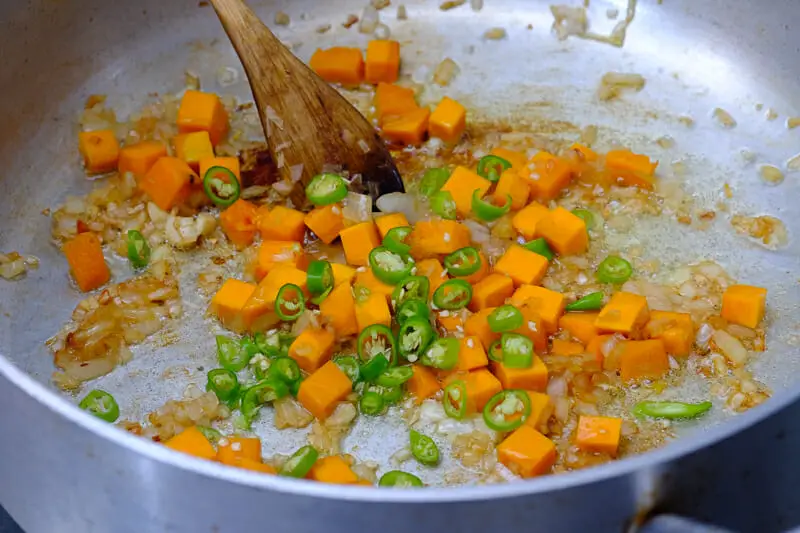
Now it’s time to work the rest of the ingredients into the pot. Add them in succession starting from those that take the longest to cook. Tough-structured root crops obviously need more time to cook than those lighter leafy tops. For this recipe, the sequence would be squash, then carrots, then cabbage, then your vegetable stock. The amount of vegetable stock may vary, so just keep in mind that every 1 cup of rice should get about 1.25 cups of stock.

To give this dish its distinct red color, add in tomato paste and give it a minute or so to get some roasting too. Roasting tomato paste would cut down its acidic flavor and deepen its color.
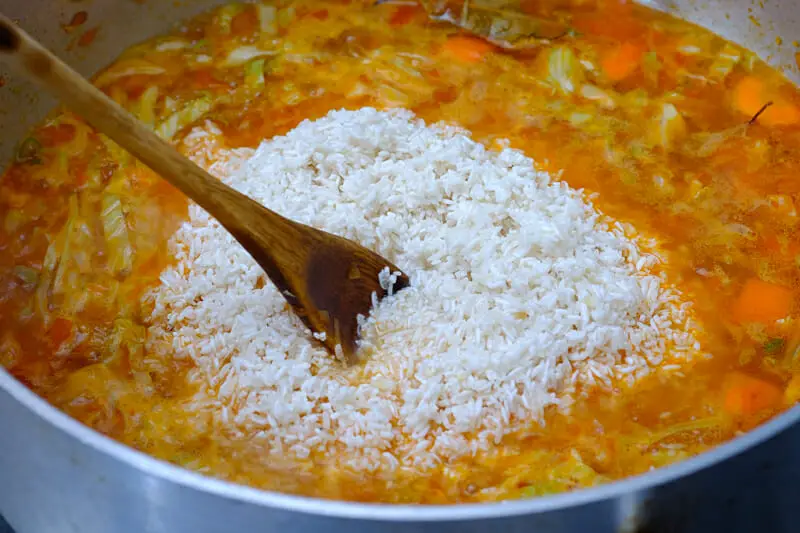
Now comes the star of the dish – the rice. Add it back in and stir thoroughly enough so get each grain coated in oil and sauce. This is also a great way to prevent the rice grains from sticking together as they cook. This is also a great time to add your eggplants in.
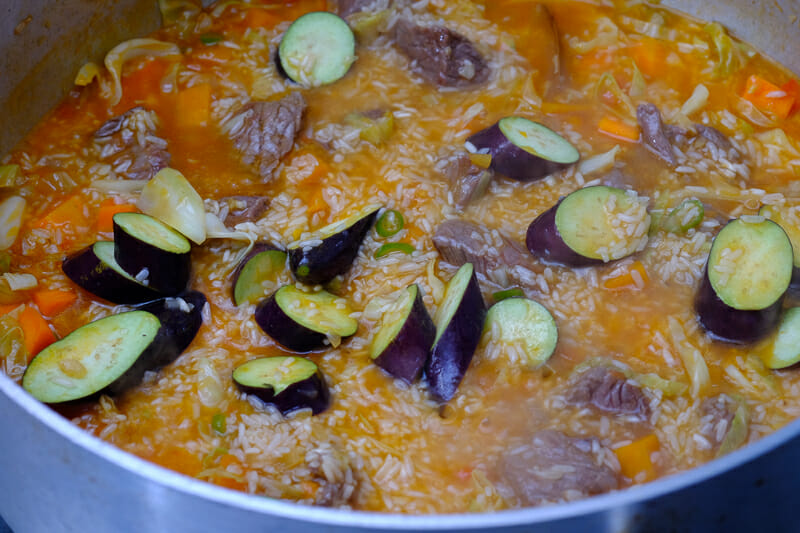
Bring your pot to boil. Continue cooking uncovered over high heat, stirring the pot once in a while as the broth starts to evaporate. When the cooking liquid levels with the height of your rice, put the lid on, adjust your flame to its lowest possible setting and leave your benachin to simmer for 15 minutes. Resist any urge to peek and see how your rice is cooking. Opening the lid even briefly will let out the steam which should be kept in there to do its job.
At this point, resist any urge to peek and see how your rice is cooking! Opening the lid even briefly will let out critical steam. Even when it’s done after 15 minutes and you’ve turned the heat off, still no peeking! Let your pot sit undisturbed for another 15 minutes so excess moisture in the pot gets absorbed by the rice too.
And then you’re done! Your benachin is ready to serve, and when you do, fluff the rice with a fork to get the grains loose.
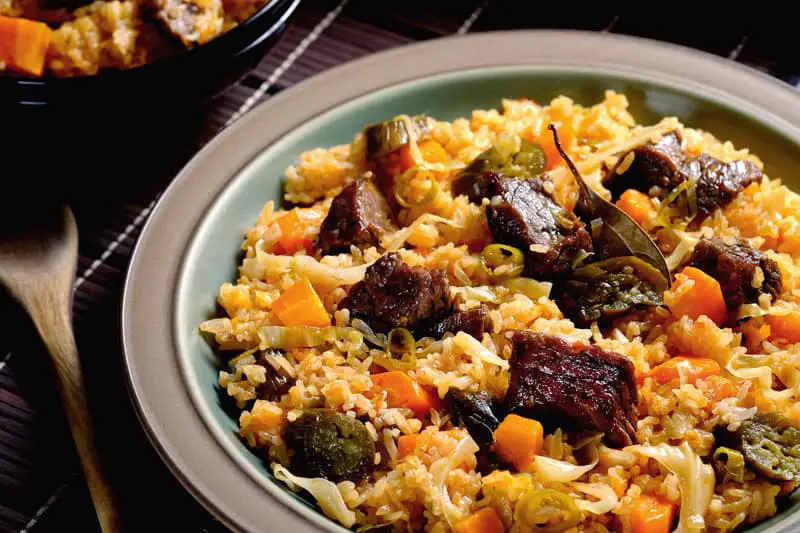
HELPERS FOR THIS RECIPE

OUR TAKE ON THE RECIPE
In our search for the most authentic way of preparing this iconic Gambian dish, we thought it would be best to refer to Gambia’s information site for a recipe. We like this source as they give different recipes for fish, beef, and chicken Benachin.
Most recipes – including the one from this source – while being true to authentic preparation, call for the use of Maggi broth cubes. We were keen on going the more all natural, healthier version for our benachin, which is why we swapped it out for vegetable broth instead. To add back in “Maggi-like” flavor, we added in garlic and used more tomatoes in our preparation.
We also made a switch to use squash instead of pumpkin for our version. We hope this doesn’t cause a stir, but we found that squash (which was more abundant for us at the time) could work equally well and yield a similar flavor.
Other than that, we did our best to stick to the traditional style. It’s a delicious dish and one that doesn’t need much else than what you see, and it makes for a wonderfully easy meal to prepare if you’ve got many mouths to feed at once.
Enjoy!


Bitcoin (BTC) might just be the golden opportunity of our era, poised to skyrocket to $200,000 in the upcoming year or the one following. In the past year alone, BTC has witnessed a staggering 20-fold increase, while other cryptocurrencies have surged by an astounding 800 times! Consider this: a mere few years ago, Bitcoin was valued at just $2. Now is the time to seize this unparalleled chance in life.
Join Binance, the world’s largest and most secure digital currency exchange, and unlock free rewards. Don’t let this pivotal moment slip through your fingers!
Click the link below to enjoy a lifetime 10% discount on all your trades.
https://swiy.co/LgSv